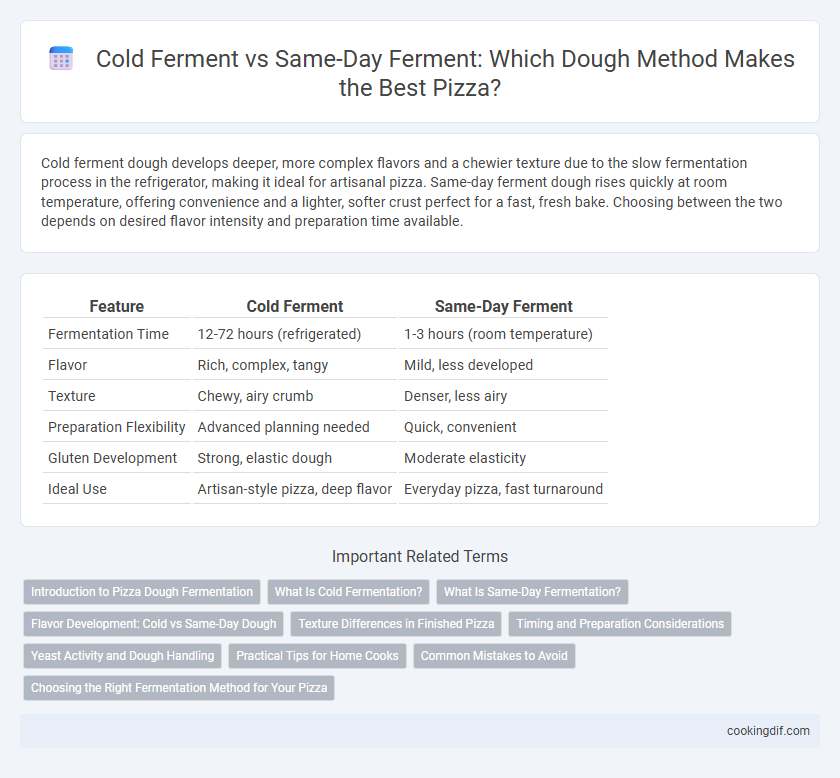Cold ferment dough develops deeper, more complex flavors and a chewier texture due to the slow fermentation process in the refrigerator, making it ideal for artisanal pizza. Same-day ferment dough rises quickly at room temperature, offering convenience and a lighter, softer crust perfect for a fast, fresh bake. Choosing between the two depends on desired flavor intensity and preparation time available.
Table of Comparison
| Feature | Cold Ferment | Same-Day Ferment |
|---|---|---|
| Fermentation Time | 12-72 hours (refrigerated) | 1-3 hours (room temperature) |
| Flavor | Rich, complex, tangy | Mild, less developed |
| Texture | Chewy, airy crumb | Denser, less airy |
| Preparation Flexibility | Advanced planning needed | Quick, convenient |
| Gluten Development | Strong, elastic dough | Moderate elasticity |
| Ideal Use | Artisan-style pizza, deep flavor | Everyday pizza, fast turnaround |
Introduction to Pizza Dough Fermentation
Cold ferment enhances pizza dough flavor and texture by allowing yeast to slowly convert sugars into carbon dioxide and alcohol over 24 to 72 hours at low temperatures. Same-day ferment accelerates this process, producing dough ready within a few hours but with less developed flavor and chewiness. Choosing between cold ferment and same-day ferment impacts dough elasticity, crust crispness, and overall pizza quality.
What Is Cold Fermentation?
Cold fermentation is a pizza dough preparation method where the dough is allowed to ferment slowly in a refrigerator at temperatures typically between 38degF and 45degF (3degC to 7degC) for 24 to 72 hours. This extended fermentation enhances the dough's flavor by allowing yeast and bacteria to break down starches and sugars, resulting in a more complex taste and improved texture with a crispier crust and chewier crumb. Compared to same-day ferment, cold fermentation provides superior gluten development and balanced acidity, making it a preferred technique for artisanal pizza dough.
What Is Same-Day Fermentation?
Same-day fermentation involves allowing pizza dough to rise for a few hours at room temperature, typically between 4 to 6 hours, resulting in a quicker preparation process compared to cold fermentation. This method produces a softer crust with a milder flavor profile due to shorter yeast activity and less time for complex sugars to develop. Pizza makers often choose same-day fermentation for faster turnaround and a tender, airy crumb ideal for thin-crust styles.
Flavor Development: Cold vs Same-Day Dough
Cold ferment dough undergoes a slow fermentation process at low temperatures, allowing wild yeast and bacteria to develop complex flavors and improved texture over 24 to 72 hours. Same-day ferment dough rises quickly at room temperature, resulting in a fresher but less nuanced taste profile with a softer crust. Cold fermentation enhances depth of flavor, acidity, and chewiness, making it preferred for artisanal pizzas with complex flavor profiles.
Texture Differences in Finished Pizza
Cold ferment dough undergoes a slow fermentation process in the refrigerator, resulting in a more complex flavor profile and chewier texture with increased gluten development. Same-day ferment dough, fermented at room temperature, produces a softer, airier crust with a lighter bite but less depth in flavor. The extended cold fermentation enhances dough extensibility and crispiness after baking, while same-day fermentation yields a tender, more delicate crumb structure.
Timing and Preparation Considerations
Cold ferment dough requires 24 to 72 hours of refrigeration, allowing enzymes to break down starches and develop complex flavors, resulting in a chewier texture. Same-day ferment dough typically needs just 2 to 4 hours at room temperature, offering quicker preparation but less depth in taste and texture. Choosing between these methods depends on the desired timing balance and flavor profile for the pizza crust.
Yeast Activity and Dough Handling
Cold ferment enhances yeast activity by slowing fermentation, resulting in complex flavor development and improved dough extensibility for easier handling. Same-day ferment accelerates yeast action, producing a quicker rise but less flavor depth and firmer dough consistency that can be more challenging to stretch. Controlled temperature and timing directly impact gluten structure, influencing the dough's elasticity and final pizza crust texture.
Practical Tips for Home Cooks
Cold ferment dough in the refrigerator for 24 to 72 hours to develop deeper flavor and improved texture, maximizing gluten structure with minimal effort. Same-day ferment requires warmer temperatures and 2 to 4 hours of rising, ideal for quick preparation but results in a less complex taste profile. Use cold fermentation for weekend meal prep and same-day ferment when time constraints demand faster pizza assembly without compromising basic dough performance.
Common Mistakes to Avoid
Common mistakes in cold ferment dough include allowing insufficient fermentation time, which results in underdeveloped flavors and a dense crust. For same-day ferment, overproofing the dough can cause excessive air pockets and a fragile structure. Maintaining the correct temperature and timing is crucial to avoid these issues and achieve optimal dough texture and taste.
Choosing the Right Fermentation Method for Your Pizza
Cold ferment enhances dough flavor and texture by allowing slow yeast activity over 24 to 72 hours in refrigeration, resulting in a chewier crust and complex taste. Same-day ferment offers a quicker rise, often within 4 to 6 hours at room temperature, yielding a softer, lighter crust suited for fast preparation. Selecting the optimal fermentation method depends on desired texture, flavor depth, and available time for dough proofing in your pizza-making process.
Cold ferment vs Same-day ferment for dough Infographic

 cookingdif.com
cookingdif.com